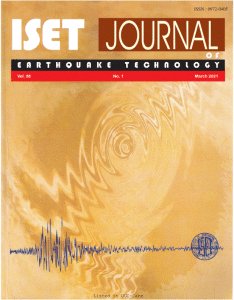Home > Issues & Journals
Time dependent seismic hazard assessment for himalayas and its implications
M.L. Sharma and S. Bajaj
Paper No.: 568
|
Vol.: 58
|
No.: 4
|
December, 2021
|
pp. 137-153

Abstract
Since the instrumental era, there has been a considerable increase in interest and relevant studies related to seismic hazard in the Himalayan region, necessitating its re-estimation with time following each destructive earthquake. Despite the capacity of classical approaches in capturing different facets of earthquake occurrence, its inability to capture time dependent occurrence of earthquakes makes ground for adoption of time dependent model, classical approaches are thus not so useful in dynamic system like Himalayas where they yield ineffective results in unrealistic predictions. This study examines non-Poissonian probabilities of exceedance in a time in future using stochastic models namely Lognormal, Brownian Passage Time, Gamma and Weibull distribution. Himalayas and its surroundings are noticeable as the region having multiple sources releasing tectonic energy; part of it may be affected by their own interactions, their varying geometry and different source of motion etc., making it a perfect case to validate different probabilistic models. The Himalaya is divided broadly into 4 SSZs viz. North-western Himalayas, Central gap region, Central Himalayas (Eastern Nepal and Sikkim) and Eastern Himalayas.
The study is done for two magnitude ranges viz: Mw≥6.0 and Mw≥7.0. The suitability among the used models in a Seismic Source Zone (SSZ) is checked based on Kolmogorov-Smirnov (K-S) test. SSZ I to IV have shown their adoption towards Gamma, Inverse-Gaussian, Lognormal and Invers-Gaussian models respectively for Mw≥6.0 and for Mw≥7.0 best model is Lognormal for SSZ I to III and Gamma for SSZ IV. The conditional probabilities for each SSZ are estimated using the best suited model for that specific SSZ.
Keywords: Himalaya; Time-Dependent Seismic Hazard; Conditional Probabilities; Weibull Distribution; Gamma Distribution; Lognormal Distribution; Inverse-Gaussian distribution.
©2025. ISET. All Rights Reserved.